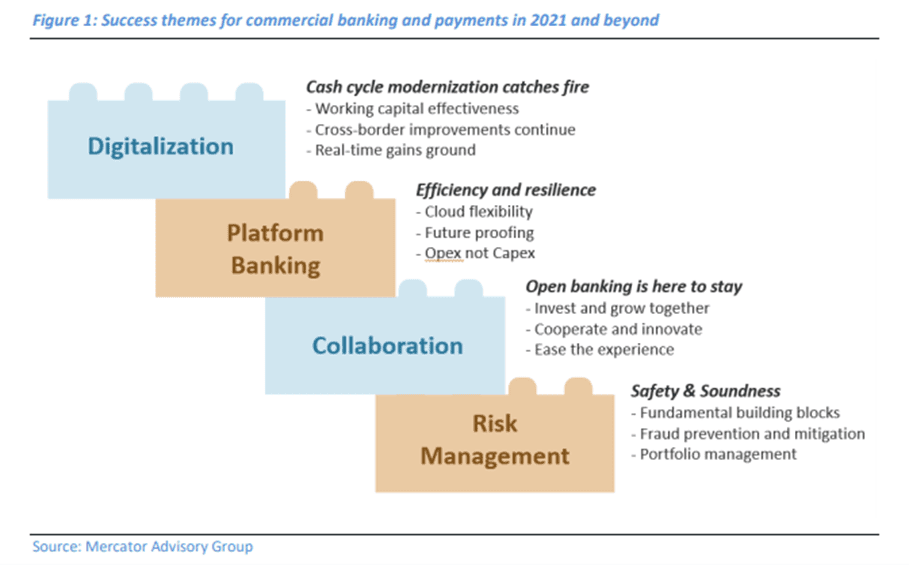Podcast: Play in new window | Download
Disruption is an ever-present threat in the banking industry as cutting-edge fintechs and solutions providers offer technology that streamlines the customer experience. But this doesn’t mean banks are doomed to fall behind. By leveraging an open-platform approach, collaborating with other industry players, and harnessing data, banks can turn the tide on disruption and come out on top.
To learn more about how banks can go from disrupted to disruptor, PaymentsJournal sat down with Robert Mancini, Head of Payments for Americas at Finastra, and Steve Murphy, Director of Commercial and Enterprise Payments Advisory Service at Mercator Advisory Group.
The pillars of banking success in the modern world
To provide some context on banking industry trends, Murphy referenced findings from a Mercator Advisory Group report from October 2020. The chart below shows that digitalization, platform banking, collaboration, and risk management are four major pillars of success for payments in 2021 and beyond:


“Digitalization of financial operations accelerated in 2020 and will continue, since corporate inertia around these types of investments has been greatly challenged by the pandemic,” explained Murphy.
Platform banking services are gaining traction as well, which is particularly important given the need to gain efficiencies for the coming shift to ISO 20022. Additionally, the move to the cloud will foster growing adoption of artificial intelligence, machine learning, and data usage. Meanwhile, risk management continues to be an ever-present priority for banks.
Industry collaboration, such as fintechs and banks working together, is another game changer. “[Banks] don’t have to reinvent customer tools and solutions, as they can integrate these proven solutions, these best-in-class products, to complete an end-to-end service for specific segments,” said Mancini. Through collaboration with other industry players, banks can elevate their value proposition by enhancing product offerings.
“In the end, banks can create an end-to-end digital experience for their customers and embed fintechs’ value proposition within that digital process. Eventually, this will lead to banking-as-a-service. I think that model will further proliferate the bank’s role across financial services in many industries. If you think about healthcare or insurance and countless others, I think this is an opportunity that banks will need to tackle promptly, as early adopters will have the most to gain here,” Mancini added.
Open platforms enable banks to meet rising consumer demands
Asked whether open platforms are living up to the hype to enable banks to meet customer needs, Mancini responded with an overwhelming yes. Two examples of this are Amazon and Uber, which have each been successful in providing customers a seamless and automated transaction process. Banks, too, are using platforms for ease of integration into fraud, compliance, and other processes.
But this is just the tip of the iceberg. “As we look to the future of platforms and how [they] will be the key driver in revenue growth and deeper penetration into supporting financial services and other verticals… banks will be able to support transformations across any vertical by leveraging the platform to automate the process end-to-end and, in some cases, reimagining the customer experience,” said Mancini.
Soon, customers will expect a seamless buying experience across all products and services. For example, it is not unrealistic to expect grocery shopping to become more automated via technology such as smart fridges and a marketplace of suppliers.
“It’s really a self-feeding process. The more you elevate that bar, the more consumers’ expectations rise, and the more that the market responds to it and the technology adopters will start bringing that into play and outperforming their competitors. I think the key question for banks, what they should be asking themselves, is why [they] are not getting ahead of this versus waiting to be further disrupted,” he continued.
Collaboration plays a key role in innovation strategy
The innovation efforts of any one player within the ecosystem of banking, fintech, big tech, and solution integration organizations simply cannot compare to the scale of innovation occurring in the space. As a result, it is unrealistic for any individual organization to expect to best serve their customers exclusively using the solutions within their four walls.
“The truth is that collaboration across the ecosystem can accelerate your value proposition and revenue growth while avoiding being disrupted. The added benefit to this model is that competition drives innovation and elevates the bar as your solutions can more easily… be interchanged via the platform,” said Mancini.
This is good news for banks looking to respond to market changes and better serve their customers. “To take it one step further,” he continued, “I think banks can collaborate with fintechs and partners to help drive their own revenue streams in a true balance of trade model.”
For example, banks can finance fintechs and enable them to monetize their services via a platform approach. This drives revenue for banks and fintechs alike, resulting in a win-win situation. While a few years ago, it was rare to hear about fintechs and banks working together, it is now becoming more commonplace as both parties see the advantage of doing so.
Data elevates the customer value proposition
The value of data is paramount for banks seeking to better serve their customers. However, it often goes under-leveraged, which is understandable given the traditionally siloed nature of data. However, it needs to change.
“I can understand that because it’s a difficult balance, as banks have the data often sitting in different silos. But the customers also trust that the banks protect that data and [do] not abuse it or share it in any way, so banks must take a cautious approach to achieve those objectives,” said Mancini.
Banks should not overlook the benefits of starting small. For example, banks may be able to use existing data to identify that a customer is using checks for disbursement instead of a more secure and efficient channel that will reap better financial gains.
“Banks have plenty of data at their fingertips, and they can even pull up via their analysis statement and look from period to period at the behaviors to make better recommendations for their customers. And this all leads to the platform,” Mancini added. A platform approach makes it possible for banks to break down these data silos, harness existing data, and bring in external data to supplement what they already have.
Murphy agreed, adding that, “if you’re not actually utilizing the data that you have by driving it through the digital tools that are available… you’re actually at a disadvantage because your competitors that are better utilizing or transforming their data into digital uses are taking advantage of the latest generation technology.”
The takeaway
In a modern world, banks need to keep up with innovation, rather than scramble to catch up. In other words, they need to be the disruptors, not the disrupted. Leveraging an open platform, harnessing data, and collaborating with other industry players makes that possible.
“Banks have an opportunity by means of leveraging technology to counter that disruption and putting the bank in control to enable itself as the central point in the ecosystem of players, whether that be fintechs or others that drive innovation and an agile approach, would be one key item as we look to the future,” summarized Mancini.










